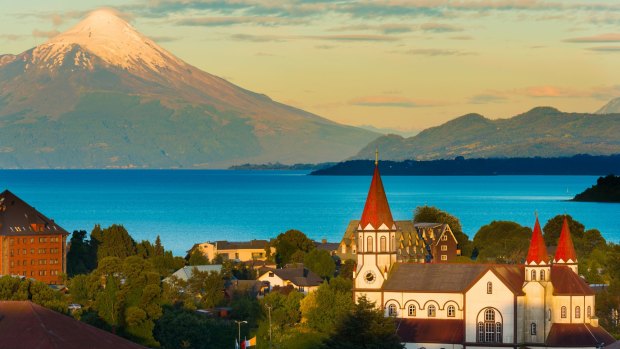This was published 2 years ago
Chile's Araucaria region: Volcanoes and lakes on a road trip through Chile's Lake District

Puerto Varas on the shores of Lake Llanquihue. Volcanoes are never far away in this region.Credit: iStock
Chile's Araucaria region is named after the monkey puzzle forests which historically criss-crossed the countryside, down the sides of volcanoes and to the very banks of the dozens of lakes which dot this extraordinary part of the world's longest country. These days, the numbers are diminished, but not so much that there aren't still dark green swathes of the unusual trees found across the countryside.
"To us, they're sacred," says Rosario Colipi inside her ruka (a traditional Mapuche home) in the de facto capital of the Araucaria region, Pucon. The Mapuche have been here almost as long as the trees, familiar with their rhythms, their spirits, and their bounty. The 68-year-old grandmother of 14 gently toasts some monkey puzzle nuts over an open fire, a satisfying almost-pine aroma mingling with the smoke.
Rosario has opened her home as part of a cultural program designed to improve understanding of indigenous Mapuche culture, under threat since the Spanish blew through this region in the days of the Conquistadors. She speaks eloquently and at length about everything from solar eclipses, to local politics, to climate change. "People should pay more attention to nature," she says succinctly. "For us, all of the answers are there if you know how to look."

Salto El Leon waterfall, PuconCredit: iStock
Despite being home to Rosario and hundreds more Mapuche, Pucon has grown to be the commercial and touristic hub of Chile's sumptuous Lake District. Here, you can buy the novelty keyrings and unwise t-shirts and two-for-one cocktails, then sign up for a tour to hike volcanoes, or jet-ski across Lake Villarrica.
Having enjoyed a few hikes around the region, including to the beautiful Cerro Espejo through an araucaria forest, I decide instead to jump in a car and head south towards Puerto Montt, a journey I stretch out over several days. The route is never straight, but it's never ugly, either. The volcanoes around Pucon may be the most visited in the area, but they are far from alone – during all 500 kilometres of my route it feels like I'm never entirely without either a lake or a volcano nearby.
Scenic Lago Ranco sits in one of the wettest areas in Chile. As the Andean condor flies, the Argentinian border isn't far from its eastern shore, but I've come instead to stay at Parque Futangue. Unlike much of the land around here, it is a private concession rather than a national park, but the Chilean owners have installed similar rules and standards, with a focus on zero impact hiking and conservation.
There's a small population of the highly-endangered Darwin frog here, while further into the undergrowth, guide Tomas Rodriguez tells me there's a vanishingly small chance of seeing a tiny wildcat known as a kodkod. "And no, I've never seen one," he says, before I've even asked the question.
Visiting in the austral autumn, it rains with a vengeance. Tomas and I shelter in a cabin on a hilltop, guessing at what might be the view below. He assures me it's spectacular, and while I'm beginning to lose faith, the cloud breaks for a few moments, revealing waterfalls tumbling down toward Lago Ranco below.
Back on the road the next day, the weather improves dramatically. This far from the big cities, the driving is remarkably sedate and the roads predominantly pothole-free – keeping eyes front and not being distracted by flocks of black-faced ibis or the sight of yet more volcanoes is as challenging as it gets.
A few hours later, I've reached Lago Llanquihue and the pretty town of Puerto Varas. This town isn't short of tour companies, either, but it's more discreet then Pucon and has resisted mass tourism to a better degree. Days could be spent here doing little more than floating around on the lake, but without time to relax and at the encouragement of a new guide, I find myself signed up for a white-water rafting experience instead.
The heavy rains of the previous days have given the rivers a particular urgency. This delights the raft's skipper Alvaro, but, from the riverbank, sends a jolt of apprehension surging through my stomach. The rest of my boat is made up of Chileans who are younger and more enthusiastic (read: braver) than me. To drop out would unbalance the boat, however, and so before I've really had a chance to protest, I'm on the water, being carried downriver. Seconds later, cold waves are smashing over the bow and into my face, and I hear myself screaming, in fear or delight.
THE DETAILS
MORE
TOUR
Journey Latin America (journeylatinamerica.com) offers a 10-day self-drive holiday in Chile's Lake District following the route Jamie did from $A6363 a person. The price includes two nights in Santiago, two at Hotel Awa in Puerto Varas, two at Futangue Hotel and Spa and three at &Beyond Vira Vira in Pucon and return domestic flights from Santiago, transfers in Santiago, a hire car in the lake district, most meals and excursions.
The writer travelled as a guest of Journey Latin America.
Sign up for the Traveller Deals newsletter
Get exclusive travel deals delivered straight to your inbox. Sign up now.